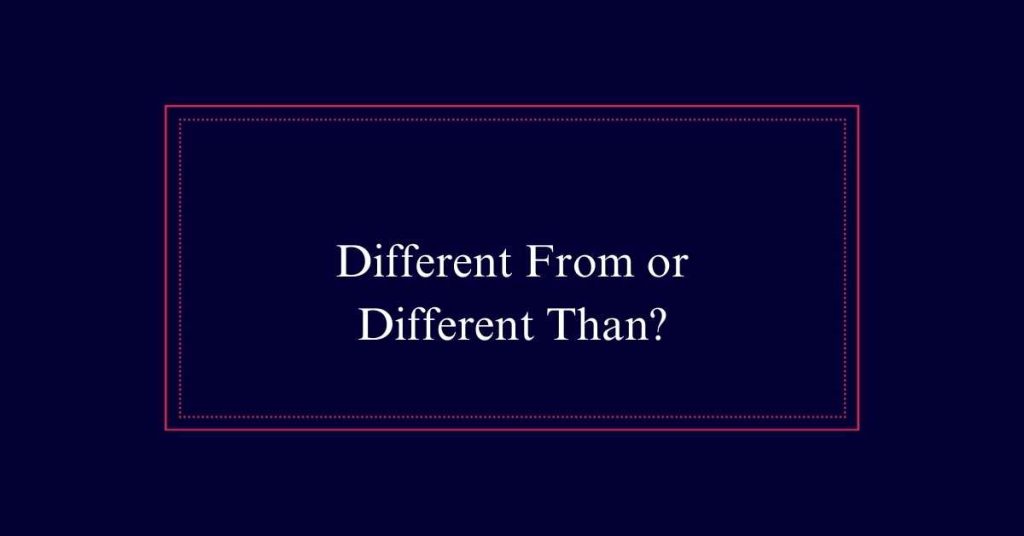Different From or Different Than?
“Different from” and “different than” are used to highlight distinctions, but they function differently. “Different from” is a preposition indicating a source of comparison and is widely used in formal writing. Example: “She is different from her sister.” “Different than” acts as a conjunction and less frequently as a preposition, often seen in informal contexts. Example: “This book is different than the one I read before.”
Preposition ‘From’
In English grammar, ‘from’ is a preposition that establishes relationships within a sentence. It indicates physical distance, origin, or cause. For example, ‘She traveled from Paris to London’ shows movement between two places.
‘From’ also signifies the source of something, as in ‘He received a gift from his friend.’ In literature, ‘different from’ is commonly used to highlight differences, as seen in works by Gabriel García Márquez and Michael Crichton. This usage adheres to formal writing standards and is widely accepted.
Conjunction ‘Than’
‘Than’ serves as both a conjunction and a preposition in English grammar.
As a conjunction, ‘than’ is used to introduce the second element in a comparison. For example, ‘She is taller than her brother.’ Here, ‘than’ connects the comparative adjective ‘taller’ to the noun ‘brother.’
As a preposition, ‘than’ is less commonly used but still acceptable in some contexts, especially in informal writing. For instance, ‘He is no different than his predecessor.’ While ‘different than’ is frequently seen in casual usage, many grammar experts recommend using ‘different from’ in formal writing. This preference helps maintain clarity and adherence to traditional grammatical standards.
Physical Distance
Understanding ‘than’ as a conjunction or preposition helps us appreciate how ‘from’ indicates physical distance in sentences.
‘From’ is a preposition that often shows the physical space separating two objects or places. For instance, one might say, ‘The library is different from the school,’ emphasizing their physical separation.
This usage clarifies that ‘from’ is not just about differences in attributes but also about spatial relationships. In professional writing, using ‘different from’ accurately conveys physical distance, enhancing clarity.
Basis and Source
From serves to indicate the basis or source of a comparison, enhancing the precision of the relationship described. When we say ‘different from,’ we are identifying the origin or foundation of the difference. This clarity is important in formal writing, where precision matters.
| Aspect | Explanation |
|---|---|
| Basis | ‘From’ clarifies the root of variation |
| Source | Highlights the origin of the difference |
| Precision | Guarantees clear and accurate comparison |
Formal Writing Preference
In formal writing, ‘different from’ is generally preferred for its clarity and correctness. This preference is supported by several authoritative guides and experts. Here are three key reasons why:
- Consistency: ‘Different from’ aligns with other prepositional uses, promoting a consistent sentence structure.
- Clarity: It avoids confusion by clearly indicating the relationship between the items being compared.
- Authority: Many grammar guides, such as ‘The Columbia Guide to Standard American English,’ recommend ‘different from’ for formal contexts.

Casual Writing Examples
Casual writing often features the phrase ‘different than’ despite its less frequent use in formal contexts. In everyday emails, social media posts, and informal blogs, ‘different than’ appears regularly. This is likely because it feels more natural to many speakers.
For example, one might say, ‘This movie is different than what I expected,’ in a casual conversation. In dialogue-driven novels and screenplays, ‘different than’ is also common. Characters use it to convey a relaxed tone.
While not incorrect, this usage is less preferred in academic or professional settings. The casual use of ‘different than’ reflects conversational English, where strict grammar rules are often relaxed for ease and flow.
Grammar Guides Advice
Grammar guides consistently recommend using ‘different from’ in formal writing for clarity and correctness. This preference is rooted in traditional grammar rules and widespread acceptance among language authorities. Many guides like ‘The Columbia Guide to Standard American English’ and ‘English Grammar for Dummies’ emphasize the importance of this usage.
Here are three key reasons:
- Clarity: ‘Different from’ clearly indicates a distinction between two items.
- Tradition: It aligns with long-established norms in formal writing.
- Authority: Respected grammar sources advocate for ‘different from’.
Literary Instances
Frequently, literature demonstrates the use of ‘different from’ to maintain formal tone and clarity. Authors like Gabriel García Márquez and Michael Crichton often employ ‘different from’ in their works. This choice helps guarantee precision and adherence to formal writing standards.
For example, Márquez’s intricate narratives often rely on clear language structure, which ‘different from’ supports. Similarly, Crichton’s scientific thrillers benefit from the straightforward clarity that ‘different from’ provides.
These literary examples show a preference for ‘different from’ to avoid ambiguity and maintain a professional tone. Such usage underscores the importance of selecting the appropriate preposition in formal writing, reinforcing the broader acceptance and correctness of ‘different from’ in literature.
Consistency in Comparisons
In formal writing, maintaining consistency in comparisons is essential for clarity and coherence. When choosing between ‘different from’ and ‘different than,’ sticking to one form throughout your document helps avoid confusion.
‘Different from’ is widely accepted in formal contexts, making it a safer and more consistent choice. Using ‘different from’ aligns with the guidelines of many style guides and guarantees your writing appears polished and professional.
Inconsistent use of ‘different from’ and ‘different than’ can distract readers and undermine your credibility. Hence, adhering to one standard form not only enhances readability but also demonstrates attention to detail.






